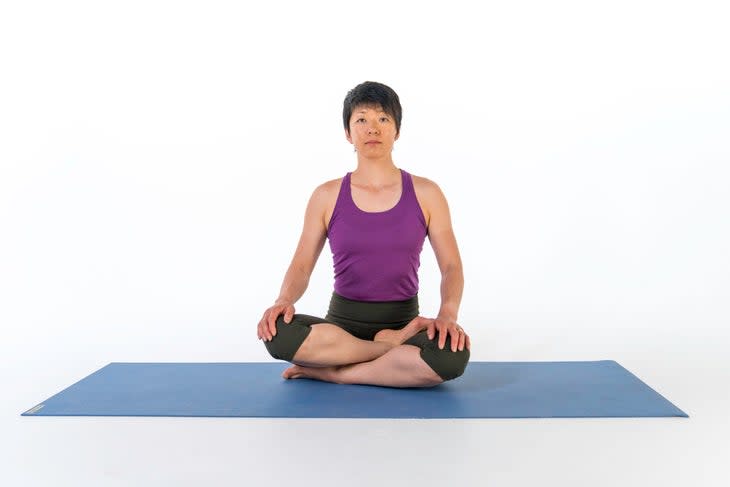Lotus Pose
Padmasana (Lotus Pose) is both a grounding and energizing pose with powerful symbolism behind it. "A lotus is rooted in the mud, and when it grows, it blooms into a beautiful flower," says Richard Rosen, director of Piedmont Yoga Studio in Oakland, California. "In the same way, when a person begins yoga, they are rooted in the mud as part of the mundane world. But as they progress, they can grow into a blooming flower."
The lotus is often found in Hindu iconography, associated with many powerful deities. Lakshmi (the goddess of abundance) is often shown sitting on an open lotus and holding another in her hand. The same is true of Ganesha, the elephant-headed destroyer of obstacles, and Lord Vishnu, who is said to represent the principle of preservation in the universe. And lore has it that wherever the Buddha walked, lotus flowers bloomed.
As important as the lotus flower is in Hindu imagery, Lotus Pose is an important foundational pose in yoga practice. This seated posture boasts many physical and energetic benefits: it can help improve circulation in the lumbar spine, stretch the ankles and legs, and increase flexibility in the hips. "What is unique about Padmasana is that it's both a grounding and a profoundly expansive pose," says ParaYoga founder Rod Stryker, who has been teaching yoga since the late 1980s. "The grounding happens in the body, but energetically it directs our awareness toward the spine and the higher centers."
Practice the pose to whatever extent your body allows, and don't get caught up in achieving a "perfect" pose.
Lotus Pose basics
Sanskrit: Padmasana (pod-MAHS-anna)
Pose Type: Seated
Targets: Hips
Why We Love It: “Whenever I’m cued to ‘come into a seated position’ during my yoga classes, I often opt to come into Lotus,” says Ellen O’Brien, Yoga Journal‘s staff writer. “This pose makes me feel grounded and at ease. Yet, at the same time, it’s a fantastic hip opener that really preps for my hips for a practice.”
Become a member today to get access to Yoga Journal’s Pose Library, which blends expert insights from top teachers with video instruction, anatomy know-how, variations, and more for dozens of poses, including Lotus Pose. It’s a resource you’ll return to again and again.
Pose Benefits
Lotus Pose creates a solid foundation for meditation practices. Settling into the pose activates the relaxation response (parasympathetic nervous system) and deactivates the stress response (sympathetic nervous system). Lotus Pose may help lower or regulate blood pressure. Physically, you can count on it to open the hip joints and stretch the front of the thighs (quadriceps), the groin, and the ankles.
Lotus Pose: Step-by-step instructions

Sit on the floor in Dandasana with your legs extended. Bend your right knee out to the side, and cradle your knee and your foot in your hands. Rotate your leg from the hip (not the knee) and guide your foot into your left hip crease.
Bend your left knee, rotating the thigh outward from the hip and, just as you did on the right. Lift your shin slightly and guide the left foot over the right, and bring it to tuck into the right hip crease.
Settle the tops of your feet against your upper thighs and release your knees towards the floor. Try not to let the ankles sickle.
Sit up tall, lift your sternum and lengthening your spine. Sitting on a folded blanket may help keep the spine from rounding.
Take slow, deep breaths and stay in the pose as long as is comfortable.
Beginner’s tips
Getting into Lotus requires both thighs to rotate outward, moving from the hip sockets. The hip is a ball-and-socket joint with a circular range of motion that varies greatly from person to person, so this pose is a breeze for some people, less so for others. Don’t judge and don’t force the pose.
When you bring your foot across toward the groin, maintain an even stretch of the inner and outer ankles in both feet. Don't allow one side of your feet or legs to feel overstrained.
Teaching Padmasana
These cues will help protect your students from injury and help them have the best experience of the pose:
Offer supportive props. If your student’s knees hover above the ground, tuck a block or folded blanket under each one to relieve any strain on the knees.
If you regularly use this pose as a platform for meditation or formal breathing practices, be sure to alternate the cross of the legs midway between your practice.
Variation: Half Lotus Pose

If the full Lotus feels intense, practice Half Lotus with one foot tucked into the opposite hip, and the other foot under the opposite knee. If you feel any knee pain, try another meditative posture like Sukhasana (Easy Pose) or Agnistambhasana (Fire Log Pose).
Preparatory poses
Agnistambhasana (Fire Log Pose)
Baddha Konasana (Bound Angle Pose)
Janu Sirsasana (Head-of-the-Knee Pose)
Counter poses
Ardha Matsyendrasana (Half Lord of the Fishes Pose)
Adho Mukha Svanasana (Downward-Facing Dog Pose)
Supta Padangusthasana (Reclining Hand-to-Big-Toe Pose)